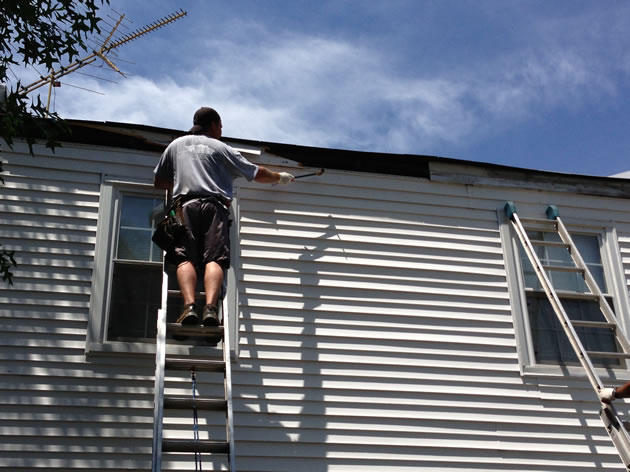Siding is a critical element of your home: it protects your home from the elements and it can either enhance or detract from your home’s “curb appeal.” Our Northern Virginia siding contractor gets a lot of questions about siding—so we thought we’d write an FAQ!
Do You Have Questions for our Siding Contractor? Contact us!
What are some signs I might need to repair or replace the siding on my home?
As a siding contractor in Northern Virginia, we can tell you that some of the signs that you may need to start a siding replacement project may come as a surprise to you. The most common signs are:
- Warped siding—If any of your siding isn’t lying flat and flush the way it should, there is a problem. Poke underneath any warped areas with a screwdriver. You should be able to tell if the material underneath is rotted. If it is, it’s time for a siding replacement.
- Sagging or peeling wall paper or paint inside your home—These symptoms of siding problems come as a surprise to a lot of people. Although there may be other reasons for peeling paint or wallpaper on the inside, if you cannot determine an internal source, your siding may be failing and letting moisture into the inner layers of your home. This moisture can cause a lot of expensive damage, so it’s important to have our Northern Virginia siding contractor check for any leaks caused by failed siding as soon as you can.
- Mold and mildew—Always alarming, mold and mildew, even on the outside of your siding, can be a sign of trouble; not to mention mold and mildew appearing on internal walls. Again, this means moisture is getting in where it shouldn’t and is a major sign your siding needs to be replaced.Dry rot—The wood underlying the siding (or if you have wood siding, that layer can be involved also) has been attacked by a fungus that eats away at it, causing the wood to become weak and easily breakable. Tapping the siding with a screwdriver handle should reveal any wood weakness. It is important for our siding contractor to determine how deep the dry rot problem is because it can adversely affect the structural integrity of your house.
What types of siding are there?
Our siding contractor works with many types of siding materials, each of which have their own list of benefits and potential concerns:
- Vinyl—This is the most common and popular type of siding today. Newer models of vinyl siding are far better than the older kinds that warped and faded more frequently, and they are generally affordable and green; we can easily recycle older vinyl siding during a siding replacement project. Vinyl siding is also one of the least expensive siding options. It comes in an expanding range of colors and can be painted over with special types of paint.
- Fiber Cement—An extremely durable, long-lasting thicker type of siding made up of wood fibers melded with cement and sand. It’s heavy, so it costs more to install, but it can be painted in a wide range of colors and it withstands wide-ranging weather conditions without buckling or warping and stands up to hail and wind very well. It’s also inflammable and low-maintenance.
- Brick—Brick siding goes on over the wooden structure as a surface application. It gets very high marks for durability and classic style and requires very little maintenance over the decades. But because it is susceptible to water, the underlying moisture barrier is very important.
- Stone—It doesn’t get any more durable than this. Stone siding provides a classic look that lasts for decades; it’s natural, green and requires minimal maintenance to maintain. However, it is the most expensive type of siding to install. Our expert siding contractor can tell you more if you want to consider this option.
- Stucco—Stucco has been around for centuries. It’s a cement-like application that usually goes over a wooden wall covered with a galvanized metal mesh-like screening and tar paper. It can also be applied to stone or brick and can be decoratively textured, tinted and painted over. It is very durable and can be one of the more affordable siding options. However, any texture may not be visible from the curb (and may appear flat), and stucco can let in moisture. So when using stucco, underlying moisture barriers are essential.
- Wood—Wood siding can come in the forms of clapboard, bevel or lap siding or singles and shakes. Because there are several variations of wood siding with a host of benefits and disadvantages, it’s important to talk with our siding contractor if you are replacing old wood siding with new wood siding. All wood siding styles require periodic maintenance like caulking and repainting to prevent weather vulnerabilities and moisture infiltration.
What siding would be best for my home?
This is a question best discussed with your siding contractor. You may also want to take a look at your homeowner’s association guidelines and insurance policy. You have to balance the concerns of durability and maintenance routines with installation costs and the overall look of your home. Just call us at 703-794-8513 with any questions!

